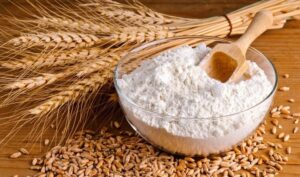
Ukrproduct Group, a major Ukrainian producer of packaged butter and processed cheese, maintained stable production levels at its main production sites in January-September 2025 and implemented business continuity protocols that had been refined since the start of the full-scale invasion.
“Exports accounted for 20.4% of total sales, strengthening the group’s position as one of Ukraine’s leading dairy exporters,” the company said in a report published on the London Stock Exchange on Thursday.
At the same time, processed cheese production volumes fell by 8.5%, which the company attributed to lower demand in the domestic market.
At the same time, Ukrproduct’s sales of processed cheese products increased by 8.1% due to consumers switching to cheaper alternatives. Sales of butter on the domestic market declined due to a significant decrease in profitability, but overall they increased by 25.8% due to exports.
The increase in exports of spreads boosted sales of spreads by 5% and sales of skimmed milk powder and skimmed milk products by 74.7%.
At the same time, kombucha sales increased by 30.6%, while kvass sales decreased by 13.3% due to cooler summer weather and a reduction in the number of keg sales outlets, the company explained.
During the period in question, Ukrproduct increased its sales of sunflower seeds more than fourfold, which it attributed to the diversification of its product range.
“Profitability remained under pressure due to dependence on diesel fuel, product spoilage, inflation in raw material prices, rising personnel costs, and continued instability in the energy sector,” the company said.
Ukrproduct Group is a large Ukrainian producer of packaged oil, processed cheese, and kvass. It produces dairy products under the trademarks Nash Molokhnik, Nash Sirok, Molendam, and Vershkovaya Dolina, as well as kvass under the trademark Arsenyevsky.
Ukrproduct Group consists of two plants in Zhytomyr (one specializing in processed cheese, the other producing kvass), as well as two enterprises in the Khmelnytskyi region: a milk plant in Starokostiantyniv, which produces packaged butter, spreads, cheese, and dry milk, and a dairy plant in Letychiv.
The group’s production facilities have the capacity to produce up to 70,000 tons of dairy products per year.

In January-November this year, Ukraine reduced manganese ore exports by 60.8% compared to the same period last year, to 17,592 thousand tons, but in August-November, it stepped up deliveries.
According to statistics released by the State Customs Service (SCS) on Friday, while deliveries in the first seven months of 2025 amounted to 2,977 thousand tons, exports more than doubled in August, when 5,037 thousand tons were exported, 1,725 thousand tons in September, 3,993 thousand tons in October, and 3,860 thousand tons in November.
In monetary terms, exports for the 11 months of 2025 fell by 56.7% compared to the same period in 2024, to $2.843 million. At the same time, the main exports were to Slovakia (99.02% of shipments in monetary terms) and Poland (0.98%).
During this period, the country imported 37,006 thousand tons worth $5.546 million from Ghana, with all deliveries taking place in November. In the first 11 months of 2024, 84,275 thousand tons of ore worth $18.212 million were imported.
As reported, in January 2024, Ukraine exported 44,903 tons of manganese ore worth $6.563 million to the US, ending a two-year hiatus in exports to foreign markets. In February-December 2024, there were no exports of manganese ore.
At the same time, for the whole of 2024, the country imported 84,293 thousand tons worth $18.302 million from Ghana (98.85%), Brazil (0.99%), and Belgium (0.11%). There were no imports in October-November.
Ukraine did not export manganese ore in 2022 and 2023, and in 2021, it exported 770 tons worth $89 thousand.
In addition, it was reported that the Pokrovsky Mining and Processing Plant (PGZK, formerly Ordzhonikidze Mining and Processing Plant) and the Marganetsky Mining and Processing Plant (MGZK, both in Dnipropetrovsk region), which are part of the Privat Group, stopped mining and processing raw manganese ore in late October-early November 2023, while NZF and ZZF stopped smelting ferroalloys. In the summer of 2024, ferroalloy plants resumed production.
PGZK and MGZK did not produce any products in 2024, while in 2023, PGZK produced 160.31 thousand tons of manganese concentrate, and MGZK was idle.
In Ukraine, manganese ore is mined and enriched by the Pokrovsky and Marganetsky mining and enrichment plants.
The consumers of manganese ore are ferroalloy enterprises.

In January-November of this year, Ukraine increased ferroalloy exports in physical terms by 26.1% compared to the same period last year, to 91,380 thousand tons.
According to statistics released by the State Customs Service (SCS) on Friday, in monetary terms, ferroalloy exports increased by 22.2% to $102.586 million.
The main exports were to Poland (27.31% of shipments in monetary terms), Algeria (22.08%), and Turkey (22.22%).
In addition, Ukraine imported 33,370 thousand tons of this product in the first 11 months of 2025, a decrease of 57.9% compared to the same period in 2024. In monetary terms, imports fell by 51.4% to $65.560 million. Imports were mainly from Norway (18.15%), Kazakhstan (15.18%), and China (11.10%).
As reported, the Pokrovsky Mining and Processing Plant (PGZK, formerly Ordzhonikidze Mining and Processing Plant) and the Marganetsky Mining and Processing Plant (MGZK, both in Dnipropetrovsk region), which are part of the Privat Group, stopped mining and processing raw manganese ore in late October-early November 2023, while NZF and ZZF stopped smelting ferroalloys. In the summer of 2024, ferroalloy plants resumed production.
PGZK and MGZK did not produce any products in 2024, while in 2023, PGZK produced 160.31 thousand tons of manganese concentrate, and MGZK was idle.
In 2024, Ukraine reduced its exports of ferroalloys in physical terms by 4.45 times compared to 2023, to 77,316 thousand tons from 344,173 thousand tons. and in monetary terms, it decreased by 3.4 times, to $88.631 million from $297.595 million. At the same time, the main exports were to Poland (27.40% of supplies in monetary terms), Turkey (21.53%), and Italy (19.82%).
In addition, Ukraine imported 82,259 tons of this product last year, compared to 14,203 tons in 2023 (a 5.8-fold increase). In monetary terms, imports increased 3.3 times, from $42.927 million to $140.752 million. Imports were mainly from Poland (32.71%), Norway (19.55%), and Kazakhstan (13.9%).
The business of ZZF, NZF, Stakhanov ZF (located at NKT), Pokrovsky and Marganetsky GZK was organized by PrivatBank prior to the nationalization of the financial institution. The Nikopol Ferroalloy Plant is controlled by the EastOne group, created in the fall of 2007 as a result of the restructuring of the Interpipe group, as well as the Privat group.

In January-November of this year, Ukraine reduced exports of titanium-containing ores and concentrates in physical terms by 95.7% compared to the same period last year, to 277 tons.
According to statistics released by the State Customs Service (SCS) on Friday, in monetary terms, exports of titanium-containing ores and concentrates fell by 95.2% to $496,000. The main exports were to Uzbekistan (35.61% of shipments in monetary terms), Turkey (35.01%), and Egypt (29.38%).
In addition, Ukraine imported 78 tons of titanium-containing ore worth $117,000 from China (98.29%, deliveries took place in January) and Kazakhstan (1.71%, deliveries took place in May) in the first 11 months of 2025.
During this period, Ukraine exported 2,466 tons of niobium, tantalum, vanadium, and zirconium ores and concentrates worth $3.954 million to Spain (48.90%), Germany (24.53%), and Italy (17.19%). At the same time, the country imported 441 tons of such ores worth $1.125 million from Spain (72.98%), the Czech Republic (12.89%), and China (11.82%).
As reported, in 2024, Ukraine reduced its exports of titanium-containing ores in physical terms by 37.5% compared to the previous year, to 7,284 thousand tons. In monetary terms, exports of titanium-containing ores and concentrates decreased by 40% to $11.654 million. The main exports were to Turkey (62.82% of shipments in monetary terms), Egypt (7.38%), and Poland (6.93%).
Last year, Ukraine imported 314 tons of titanium-containing ore worth $492 thousand from China (87.78%), Vietnam (6.11%), and Senegal (also 6.11%).
At the same time, experts pointed out the inconsistency of statistics on exports of titanium-containing ores. However, in response to a request from Interfax-Ukraine, the State Customs Service (SFS) of Ukraine stated that complete data on the export of titanium raw materials is not provided due to restrictions on the volume of export and import operations with military and dual-use goods, which are reflected in aggregate form under “Other goods.” They explained that, in particular, deliveries of titanium-containing ores from companies differ from the SCS data.
“We would like to inform you that these deliveries are included in the statistical exports from Ukraine, but are not reflected in the foreign trade statistics published by the State Customs Service (…) under commodity item UKTZED 2614 ”Titanium ores and concentrates” in view of the following (…) In accordance with the regulations (…), when protecting data for confidentiality purposes, any information considered confidential is reported in full at the next, higher level of product data aggregation,” the State Customs Service explained in its response to the agency.
It was clarified that information on customs clearance and movement across the customs border of Ukraine of goods subject to export control is included in the list of information containing official information in the SSU, in accordance with the relevant order.
In Ukraine, titanium-containing ores are currently mined mainly by PJSC “United Mining and Chemical Company” (UMCC), which manages the Vilnohirsk Mining and Metallurgical Plant (VGMK, Dnipropetrovsk region) and the Irshansk Mining and Processing Plant (IGZK, Zhytomyr region), as well as LLC “Mezhirichensky GZK” and LLC “Valky-Ilmenite” (both LLCs are located in Irshansk, Zhytomyr region). In addition, the production and commercial firm Velta (Dnipro) built a mining and processing plant at the Birzulivskyi deposit with a capacity of 240,000 tons of ilmenite concentrate per year.

Ukraine increased imports of goods in January-November 2025 by 18.5% in monetary terms to $75.4 billion, while exports decreased by 4.02% to $36.8 billion from $38.3 billion, according to the State Customs Service of Ukraine (SCS).
“At the same time, taxable imports amounted to $57.6 billion, which is 76% of the total volume of imported goods. The tax burden per 1 kg of taxable imports in January-November 2025 was $0.52/kg,” the SSU notes.
The countries from which the most goods were imported to Ukraine included China ($17 billion), Poland ($7.1 billion), and Germany ($5.9 billion).
The largest exports from Ukraine were to Poland ($4.6 billion), Turkey ($2.5 billion), and Germany ($2.2 billion).
Of the total volume of goods imported in January-November 2025, 67% fell into the following categories: machinery, equipment, and transport – $30.2 billion (during customs clearance of these goods, UAH 185.8 billion, or 29% of customs payments, was paid to the budget); chemical industry products – $11.4 billion (UAH 89 billion, or 14% of customs payments, was paid to the budget), fuel and energy products – $9.4 billion (UAH 188.4 billion, or 29% of customs payments, was paid).
The top three most exported goods from Ukraine were food products – $20.4 billion, metals and metal products – $4.3 billion, machinery, equipment, and transport – $3.4 billion.
“In the first 11 months of 2025, during customs clearance of exports of goods subject to export duties, UAH 1.2 billion was paid to the budget,” the SSU added.

For the first time in 2025, a separate annual quota for the supply of 30,000 tons of Ukrainian flour to the European Union has been granted, which opens up opportunities for long-term planning for the domestic flour milling business, said Rodion Rybchinsky, director of the Ukrainian Flour Millers Association.
“The top 10 export-oriented companies have already invested around EUR 17 million in modernization and now understand that these investments will have prospects,” he said at the “Agribusiness in Ukraine” conference in Kyiv on Thursday.
He recalled that until 2022, flour was exported within the joint quota with wheat. Flour millers usually did not have time to deliver their products to the EU, as grain traders were the first to choose the quota. Only after the opening of trade preferences in 2022 did Ukrainian flour begin to actively enter the EU market, and in 2023, flour exports to EU countries amounted to 73,000 tons.
“These volumes became an argument in the negotiations: if 73,000 tons were successfully delivered to the EU, the question of Ukrainian flour’s non-compliance with European quality requirements would be moot,” said Rybchynskyi.
According to him, Ukrainian flour is now available in Germany, the Czech Republic, Spain, and Italy, which is clear proof of the high quality of Ukrainian products.
Rybchynskyi noted that during the 11 months of 2025, Ukraine supplied 26,000 tons of this product to the EU, so by the end of the year, domestic producers will be able to fully use the quota. At the same time, the biggest problem for flour millers in 2026, if we assess the prospects of the industry, will be the labor shortage.
He named the European Millers’ Congress in France as one of the most anticipated events in the industry next year, during which the Ukrainian side will try to find arguments and establish contact, in particular, with the Romanian Association of Flour Producers, as well as try to lay the groundwork for a review of quotas in 2028. According to Rybchynsky’s estimates, Ukraine is capable of supplying 300,000 tons of flour to the EU market.